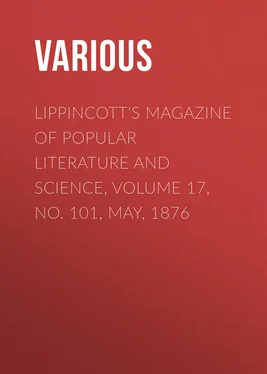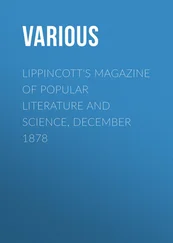Various - Lippincott's Magazine of Popular Literature and Science, Volume 17, No. 101, May, 1876
Здесь есть возможность читать онлайн «Various - Lippincott's Magazine of Popular Literature and Science, Volume 17, No. 101, May, 1876» — ознакомительный отрывок электронной книги совершенно бесплатно, а после прочтения отрывка купить полную версию. В некоторых случаях можно слушать аудио, скачать через торрент в формате fb2 и присутствует краткое содержание. Издательство: Иностранный паблик, Жанр: foreign_antique, periodic, foreign_edu, на английском языке. Описание произведения, (предисловие) а так же отзывы посетителей доступны на портале библиотеки ЛибКат.
- Название:Lippincott's Magazine of Popular Literature and Science, Volume 17, No. 101, May, 1876
- Автор:
- Издательство:Иностранный паблик
- Жанр:
- Год:неизвестен
- ISBN:нет данных
- Рейтинг книги:3 / 5. Голосов: 1
-
Избранное:Добавить в избранное
- Отзывы:
-
Ваша оценка:
- 60
- 1
- 2
- 3
- 4
- 5
Lippincott's Magazine of Popular Literature and Science, Volume 17, No. 101, May, 1876: краткое содержание, описание и аннотация
Предлагаем к чтению аннотацию, описание, краткое содержание или предисловие (зависит от того, что написал сам автор книги «Lippincott's Magazine of Popular Literature and Science, Volume 17, No. 101, May, 1876»). Если вы не нашли необходимую информацию о книге — напишите в комментариях, мы постараемся отыскать её.
Lippincott's Magazine of Popular Literature and Science, Volume 17, No. 101, May, 1876 — читать онлайн ознакомительный отрывок
Ниже представлен текст книги, разбитый по страницам. Система сохранения места последней прочитанной страницы, позволяет с удобством читать онлайн бесплатно книгу «Lippincott's Magazine of Popular Literature and Science, Volume 17, No. 101, May, 1876», без необходимости каждый раз заново искать на чём Вы остановились. Поставьте закладку, и сможете в любой момент перейти на страницу, на которой закончили чтение.
Интервал:
Закладка:
At the side of the Kindergarten springs a more indigenous growth—the Women's School-house. In this reminder of early days we may freshen our jaded memories, and wonder if, escaped from the dame's school, we have been really manumitted from the instructing hand of women, or ever shall be in the world, or ought to be.
Is the "New England Log-house," devoted to the contrasting of the cuisine of this and the Revolutionary period, strictly to be assigned to the women's ward of the great extempore city? Is its proximity to the buildings just noticed purely accidental, or meant to imply that cookery is as much a female art and mystery as it was a century ago? However this may be, the erection of this temple to the viands of other days was a capital idea, and a blessed one should it aid in the banishment of certain popular delicacies which afflict the digestive apparatus of to-day. This kitchen of the forest epoch is naturally of logs, and logs in their natural condition, with the bark on. The planking of that period is represented by clap-boards or slabs. Garnished with ropes of onions, dried apples, linsey-woolsey garments and similar drapery, the aspect of the walls will remind us of Lowell's lines:
Crook-necks above the chimly hung,
While in among 'em rusted
The old Queen's-arm that Gran'ther Young
Brought hack from Concord busted.
The log-house is not by any means an abandoned feature of antiquity. It is still a thriving American "institution" North, West and South, only not so conspicuous in the forefront of our civilization as it once was. It turns out yet fair women and brave men, and more than that—if it be not treason to use terms so unrepublican—the highest product of this world, gentlemen and gentlewomen.
Uncle Sam confronts the ladies from over the way, a ferocious battery of fifty-seven-ton Rodman guns and other monsters of the same family frowning defiance to their smiles and wiles. His traditional dread of masked batteries may have something to do with this demonstration. He need not fear, however. His fair neighbors and nieces have their hands full with their own concerns, and leave him undisturbed in his stately bachelor's hall to "illustrate the functions and administrative faculties of the government in time of peace and its resources as a war-power." To do this properly, he has found two acres of ground none too much. The building, business-like and capable-looking, was erected in a style and with a degree of economy creditable to the officers of the board, selected from the Departments of War, Agriculture, the Treasury, Navy, Interior and Post-Office, and from the Smithsonian Institution. Appended to it are smaller structures for the illustration of hospital and laboratory work—a kill-and-cure association that is but one of the odd contradictions of war.
The sentiments prevalent in this era of perfect peace, harmony and balance of rights forbids the suspicion of any significance in the fact that the lordly palace of the Federal government at once overshadows and turns its back upon the humbler tenements of the States. A line of these, drawn up in close order, shoulder to shoulder, is ranged, hard by, against the tall fence that encloses the grounds. The Keystone State, as beseems her, heads the line by the left flank. Then come, in due order, Ohio, Indiana, Illinois, Michigan, Wisconsin, New Hampshire, Connecticut, Massachusetts and Delaware. New Jersey and Kansas stand proudly apart, officer-like, on the opposite side of the avenue; the regimental canteen, in the shape of the Southern Restaurant, jostling them rather too closely. Somewhat in keeping with the over-prominence of the latter adjunct is the militia-like aspect of the array, wonderfully irregular as are its members in stature and style. Pennsylvania's pavilion, costing forty thousand dollars, or half as much as the United States building, plays the leading grenadier well; but little Delaware, not content with the obscure post of file-closer, swells at the opposite end of the line into dimensions of ninety by seventy-five feet, with a cupola that, if placed at Dover, would be visible from half her territory.
These buildings are all of wood, with the exception of that of Ohio, which exhibits some of the fine varieties of stone furnished by the quarries of that State, together with some crumbling red sandstone which ought, in our opinion, to have been left at home. All have two floors, save the Massachusetts cottage, a quaint affair modeled after the homes of the past. Virginia ought to have placed by its side one of her own old country-houses, long and low, with attic windows, the roof spreading with unbroken line over a portico the full length of the front, and a broad-bottomed chimney on the outside of each gable. The State of New York plays orderly sergeant, and stands in front of Delaware. She is very fortunate in the site assigned her, at the junction of State Avenue with several broad promenades, and her building is not unworthy so prominent a position.
From the Empire State we step into the domain of Old England. Three of her rural homesteads rise before us, red-tiled, many-gabled, lattice-windowed, and telling of a kindly winter with external chimneys that care not for the hoarding of heat. It is a bit of the island peopled by some of the islanders. They are colonized here, from commissioner in charge down to private, in a cheek-by-jowl fashion that shows their ability to unbend and republicanize on occasion. Great Britain's head-quarters are made particularly attractive, not more by the picturesqueness of the buildings than by the extent and completeness of her exhibit. In her preparations for neither the French nor the Austrian exposition did she manifest a stronger determination to be thoroughly well represented. Col. H.B. Sanford, of the Royal Artillery, heads her commission.
Japan is a common and close neighbor to the two competitors for her commercial good-will, England and New York. Modern Anglo-Saxondom and old Cathay touch eaves with each other. Hemlock and British oak rub against bamboo, and dwellings which at first sight may impress one as chiefly chimney stand in sharp contrast with one wholly devoid of that feature. The difference is that of nails and bolts against dovetails and wooden pins; of light and pervious walls with heavy sun-repelling roof against close and dense sides and roofs whose chief warfare is with the clouds; of saw and plane that work in Mongol and Caucasian hands in directions precisely reversed. To the carpenters of both England and Japan our winter climate, albeit far milder than usual, was alike astonishing. With equal readiness, though not with equal violence to the outer man , the craftsmen of the two nations accommodated themselves to the new atmospheric conditions. The moulting process, in point of dress, through which the Japanese passed was not untypical of the change the institutions of their country have been undergoing in obedience to similarly stern requirements. It did not begin at quite so rudimental a stage of costume as that of the porters and wrestlers presented to us on fans, admirably adapted as that style might be to our summer temperature. In preparing for that oscillation of the thermometer the English are called on for another change, whereas the Orientals may meet it by simply reverting to first principles.
Читать дальшеИнтервал:
Закладка:
Похожие книги на «Lippincott's Magazine of Popular Literature and Science, Volume 17, No. 101, May, 1876»
Представляем Вашему вниманию похожие книги на «Lippincott's Magazine of Popular Literature and Science, Volume 17, No. 101, May, 1876» списком для выбора. Мы отобрали схожую по названию и смыслу литературу в надежде предоставить читателям больше вариантов отыскать новые, интересные, ещё непрочитанные произведения.
Обсуждение, отзывы о книге «Lippincott's Magazine of Popular Literature and Science, Volume 17, No. 101, May, 1876» и просто собственные мнения читателей. Оставьте ваши комментарии, напишите, что Вы думаете о произведении, его смысле или главных героях. Укажите что конкретно понравилось, а что нет, и почему Вы так считаете.












